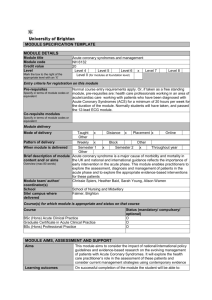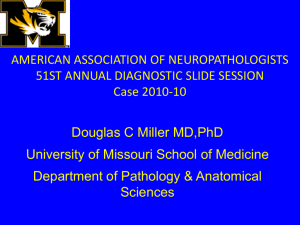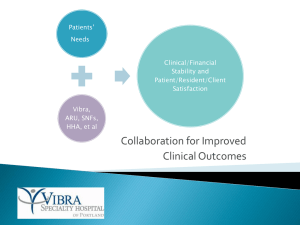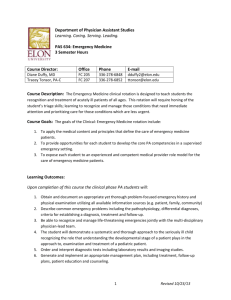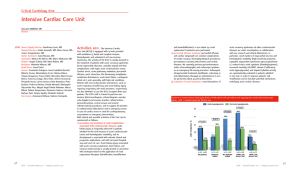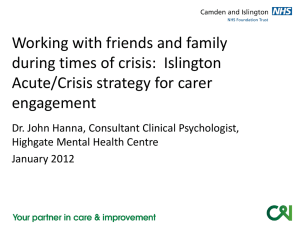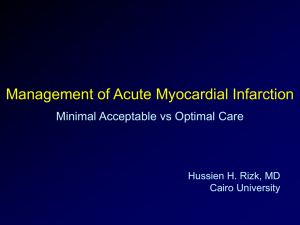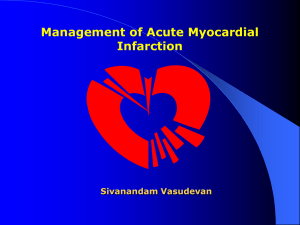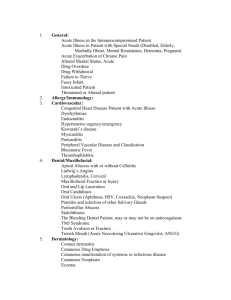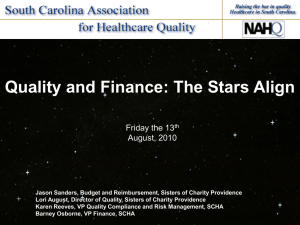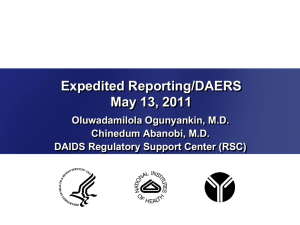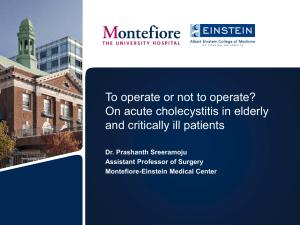Title of presentation (Arial bold 32 pt, default blue, initial cap only)
advertisement
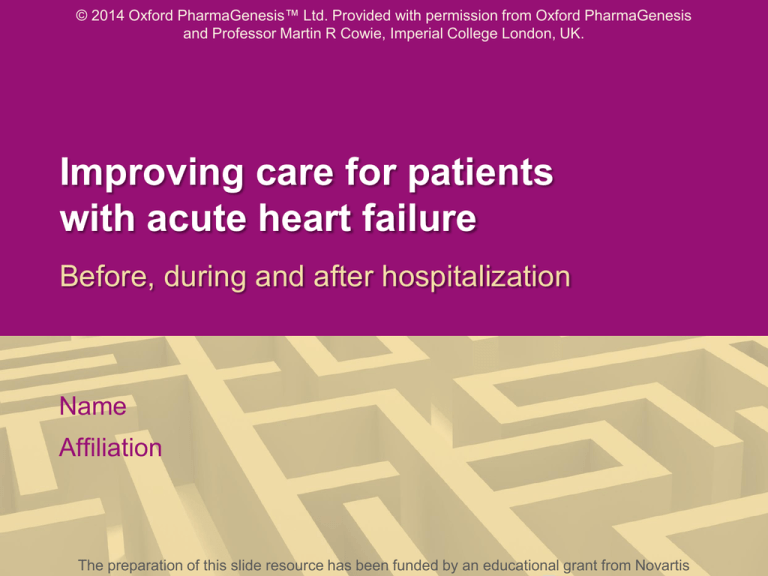
© 2014 Oxford PharmaGenesis™ Ltd. Provided with permission from Oxford PharmaGenesis and Professor Martin R Cowie, Imperial College London, UK. Improving care for patients with acute heart failure Before, during and after hospitalization Name Affiliation The preparation of this slide resource has been funded by an educational grant from Novartis Eight policy recommendations for acute heart failure from an international group of experts ● Martin R Cowie UK ● Stefan D Anker Germany ● John GF Cleland UK ● G Michael Felker USA Endorsed by ● Gerasimos Filippatos Greece ● Tiny Jaarsma Sweden ● Patrick Jourdain France ● Eve Knight UK ● Barry Massie USA ● Piotr Ponikowski Poland ● José López-Sendón Spain 2 Acknowledgements ● These slides are based on a policy report and recommendations funded by educational grants from Novartis and Cardiorentis – The grants covered meeting costs, honoraria, travel expenses and the services of Oxford PharmaGenesis™ Ltd, UK, who provided support for the independent writing and editing of the report. www.oxfordhealthpolicyforum.org /AHFreport © 2014 Oxford PharmaGenesis™ 3 What is acute heart failure and how big is the problem? Acute heart failure is a rapid weakening of the heart’s ability to supply blood to the body ● Typical symptoms Relaxation Right atrium Right ventricle Left atrium Left ventricle Aorta Contraction – Breathlessness – Leg or ankle swelling – Extreme fatigue ● Often a life-threatening medical emergency ● Underlying problem(s) with the heart’s structure or function, e.g. – Enlarged ventricles Ventricular muscle – Thickened ventricular muscle – Stiffened ventricle walls – Poorly functioning valves 5 Acute heart failure has many causes, some of which are preventable Rhythm disorders Heart muscle dysfunction (cardiomyopathy) Valve dysfunction High blood pressure Heart-related factors Other cardiac disorders Poor blood (e.g. cardiac tamponade) supply (myocardial ischaemia) Failure to take heart failure medications Poor blood supply (pulmonary embolism) Lung-related factors Lung disease (asthma, COPD) Pulmonary hypertension ACUTE HEART FAILURE Anaemia Other medical conditions Starting certain Treatment and Alcohol or medications (e.g. that lifestyle factors drug misuse affect cardiac function or salt retention) Excessive Diet Infections (excessive salt/ physical activity fluid intake) Renal dysfunction Diabetes Thyroid disorders 6 Acute heart failure has many causes, some of which are preventable Rhythm disorders Heart muscle dysfunction (cardiomyopathy) Valve dysfunction High blood pressure Heart-related factors Other cardiac disorders Poor blood (e.g. cardiac tamponade) supply (myocardial ischaemia) Failure to take heart failure medications Poor blood supply (pulmonary embolism) Lung-related factors Lung disease (asthma, COPD) Pulmonary hypertension ACUTE HEART FAILURE Anaemia Other medical conditions Starting certain Treatment and Alcohol or medications (e.g. that lifestyle factors drug misuse affect cardiac function or salt retention) Excessive Diet Infections (excessive salt/ physical activity fluid intake) Renal dysfunction Diabetes Thyroid disorders 7 Heart failure is common and affects mainly older people ● About 1 person in 5 will develop heart failure ● More than 10% of people aged over 75 years have heart failure – Affects few people aged under 50 years in Europe and the USA ● Heart failure is the most common cause of hospitalization of people aged over 65 years ● High risk of heart failure among socio-economically disadvantaged people – Especially older women 8 Heart failure accounts for 1–3% of all hospital admissions in Europe and the USA USA (2007) Norway (2008) Sweden (2011) 1.1% 2.2% Netherlands (2010) 1.5% 2.9% Poland (2010) Lower Silesia region 1.5% England (2011–12) Germany (2007) 0.4–2.5% 2.0% Spain (2011) Switzerland (2011) Austria (2010) 1.8% 1.1% 2.0% 9 In-hospital and 1-year death rates of patients admitted to hospital with heart failure Death in hospital VA health care system (USA) OPTIMIZE-HF (USA) ADHERE (USA) Medicare (USA) Worcester HF (USA) Medicare (USA) ESC-HF Pilot (Europe) EHFS II (Europe) EHFS (Europe) NICOR (England/Wales) FINN-AKVA (Finland) OFICA (France) IN-HF Outcome (Italy) EAHFE (Spain) Heart failure study Death within 1 year 0 10 20 30 40 Death rate (%) 10 High hospital readmission rates of patients with acute heart failure 30 days Medicare (USA) 12 weeks Heart failure study Medicare (USA) 1 year VA health care system (USA) ADHERE (USA) Medicare (USA) EHFS (Europe) ESC-HF Pilot (Europe) IN-HF Outcome (Italy) EAHFE (Spain) 0 10 20 30 40 50 60 70 80 Rehospitalization rate (%) 11 Heart failure: a substantial economic cost to society ● Heart failure accounts for 1−2% of total healthcare expenditure in Europe and North America – Care in hospital makes up most of the cost – $39.2 billion in 2010 in the USA ● Typical length of hospital stay is 5–10 days ● Total healthcare costs are estimated to rise by 50–100% in the coming decade 12 Eight policy recommendations Improving care and preventing deaths of patients with acute heart failure Policy recommendation Promote acute heart failure prevention Country-wide efforts to decrease risk factors for heart failure, including high blood pressure and coronary artery disease, should be intensified 14 Patients’ healthcare experiences vary depending on symptoms and service provision aPossible future provision 15 Episodes of acute heart failure become more likely and more severe as disease progresses Heart failure prevention Excellent physical function Heart failure prevention Period without symptoms Heart failure care Gradual appearance of symptoms A First episode C B D Death Time 16 Policy recommendation Optimize care transitions Better integration of hospital care, community care and the emergency services will improve patient outcomes and enable more efficient use of resources 17 Policy recommendation Improve end-of-life care Effective approaches to palliative and end-of-life care, addressing emotional and physical well-being, need to be made an integral part of the care of patients with heart failure, both in hospital and in the community 18 Not all patients with heart failure receive care in accordance with guidelines ● Wide variations in hospital performance in acute heart failure have been reported ● Use of checklists, protocols and care pathways for managing patients with acute heart failure can reduce deaths Compliance (%) 100 80 10th percentile 25th percentile 50th percentile 75th percentile 90th percentile 60 40 20 0 Discharge instructions Smoking counselling Medication at discharge LV function assessed 19 Policy recommendation Provide equity of care for all patients All patients should have timely access to an appropriate range of diagnostic procedures, therapies and long-term follow-up care 20 Care in specialist units reduces the likelihood of death in hospital or soon after discharge 100 ● Teamwork between cardiologists and other physicians and nurses is essential Survival rate (%) 80 – Emergency department 60 – Internal medicine Cardiology General medicine Other 40 – Intensive care – Outside hospital 20 ● Patients and public alike can recognize ‘good care’ 0 0 100 200 300 400 Time after discharge (days) Reproduced with permission from National Institute for Cardiovascular Outcomes Research (NICOR), University College London, UK 21 Policy recommendation Appoint experts to lead heart failure care across disciplines A multidisciplinary team led by a heart failure expert should oversee the care of patients with acute heart failure and the development of protocols, training and local auditing to make excellent care the norm 22 Policy recommendation Develop and implement better measures of care quality Performance measures based on robust, evidence-based clinical recommendations should be developed and used to improve the quality of care for patients with acute heart failure 23 Active involvement of patients in their long-term care is important for good outcomes The three components of patient self-care Maintenance Monitoring Management Sustaining physical and emotional stability Keeping watch on signs and symptoms Responding to changes in signs and symptoms 24 Patients with heart failure do not always adopt good self-care behaviours ● 31% of newly discharged patients could not name any symptom of worsening heart failure Medication adherence Symptom monitoring Smoking cessation ● Confusing or conflicting advice are major reasons why patients do not take medication as prescribed Low-salt diet Alcohol cessation ● Support from friends, family or the community can promote self-care behaviours in patients Daily weighing Low-fat diet Regular exercise 0 20 40 60 80 100 Patients showing good adherence (%) 25 Policy recommendation Improve patient education and support Better education and support for individuals with heart failure, and their families and caregivers, are essential to improve outcomes and patients’ experience of care 26 Treatment options for acute heart failure have not changed for 20 years ● Current treatments control symptoms but do not prolong life – Reduce fluid build-up – Alter blood pressure – Increase force of contractions ● Evaluating efficacy of new treatments is complex – Many causes and consequences of heart failure – Challenge of conducting clinical trials in the emergency setting ● New treatments are urgently required to address unmet needs 27 Policy recommendation Stimulate research into new therapies Increased funding is needed for research into new and more effective therapies, medical devices and care strategies for acute heart failure 28 We urge policy-makers to act on these eight recommendations Promote acute heart failure prevention Optimize care transitions Improve end-of-life care Provide equity of care for all patients Appoint experts to lead heart failure across disciplines Develop and implement better measures of care quality Improve patient education and support Stimulate research into new therapies www.oxfordhealthpolicyforum.org /AHFreport © 2014 Oxford PharmaGenesis™ 29


